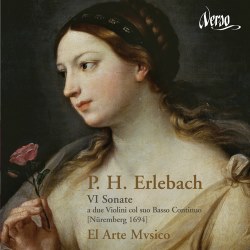|

|
Philipp Heinrich ERLEBACH (1657-1714)
Sonata I in D [11:37]
Sonata II in e minor [10:37]
Sonata III in A [13:29]
Sonata IV in C [11:14]
Sonata V in B flat [9:03]
Sonata VI in F [10:05]
El Arte Mvsico (Ángel Sampredo, Teresa Casanova (violin), Isabel Gómez-Serranillos (cello), Diego Fernández (harpsichord))
rec. July 2012, Iglesia Parroquial Immaculada Concepción, Bustarviejo, Madrid
VERSO VRS 2146 [66:32]
It is astonishing how much music was written during the 17th century. That’s particularly true of Germany, largely due to its political structure. It comprised many towns, duchies and counties each with a large degree of independence. They all had their own musical establishments and as music was an organic part of everyday life there were many opportunities for composers to write vocal and instrumental pieces. Today we only know a relatively small proportion of this repertoire. Part of it is in libraries and archives, sometimes still uncatalogued. However, large parts of it have also been lost.
The composer of the sonatas on the present disc is a good example: more than 90 percent of his output was burnt in 1735 in a fire in the library of the Heidecksburg castle in the county of Schwarzburg-Rudolstadt. Here Erlebach worked as Kapellmeister from 1861 until his death. His total output is estimated at around 1,000 pieces; about seventy were saved and among them are the sonatas played here.
In the second half of the 17th century many German aristocrats were under the spell of the splendour of Louis XIV's court. They liked to listen to music of the kind that was played there, for instance by Lully. This resulted in various German composers writing music in that same style; Erlebach was one of them. This aspect comes to the fore in his VI Ouvertures in the French manner which were published in 1693. One year later the VI Sonate were printed. They are scored for violin, viola da gamba and bc, but Erlebach offered an alternative scoring for two violins and bc. The original scoring is in line with the German tradition: many sonatas for violin and viola da gamba were composed and published, for instance by Dietrich Buxtehude in his op. 1 and op. 2. The scoring for two violins reflects the modern fashion, influenced by the dissemination of Italian trio sonatas, especially those by Corelli.
Although Erlebach can be considered a representative of the 'mixed taste' in which German, French and Italian elements are blended, these sonatas show a strong Italian flavour. They begin with three movements or one movement in three sections in the sequence of slow - fast - slow. Next are four dance movements with French titles. However, Erlebach apologised for the fact that - due to time pressure during the printing process - "some mistakes contrary to the Italian dialect slipped into the titles in which, in stead of Allemande, Courante, Saraband, Variatio and Gigue, should have appeared Allamanda, Corrente, Sarabanda e Variata and Giga". That doesn't mean that there are no French elements. Sonata III ends with a ciaconne which is reminiscent of French chaconnes as they were so often included in suites for keyboard and for instrumental ensemble. Moreover, in five of the sonatas the sarabande is followed by a variatio which seems inspired by the French habit of adding a double to a dance movement.
There are also German elements in these sonatas. Firstly, Erlebach frequently makes use of counterpoint. Secondly, in three sonatas (III, IV and VI) the violins play in scordatura which means that the normal tuning of the violin is adapted to the tonality of the composition. This technique was a speciality of the German-Austrian violin school, and in particular of Heinrich Ignaz Franz von Biber. It’s also notable that the Sonata VI requires violini piccoli - probably the first time they were used in German music.
This set of six sonatas has been recorded before in their original scoring for violin and viola da gamba by Rodolfo Richter and Alison McGillivray (review). This disc is no competition as in this case we hear the sonatas in the alternative scoring. That makes it an interesting complement. El Arte Mvsico delivers technically accomplished performances which are expressive and show a thorough understanding of the idiom. The dance rhythms are very well exposed, thanks to a clear distinction between stressed and unstressed notes and an effective dynamic shading. The use of a cello in the basso continuo is questionable. It seems that it made its appearance in Germany only after the turn of the century.
This is a compelling disc which demonstrates the quality of Erlebach's music and makes it all the more regrettable that so much of it has been lost forever.
Johan van Veen
http://www.musica-dei-donum.org
https://twitter.com/johanvanveen
 |
 |
|
